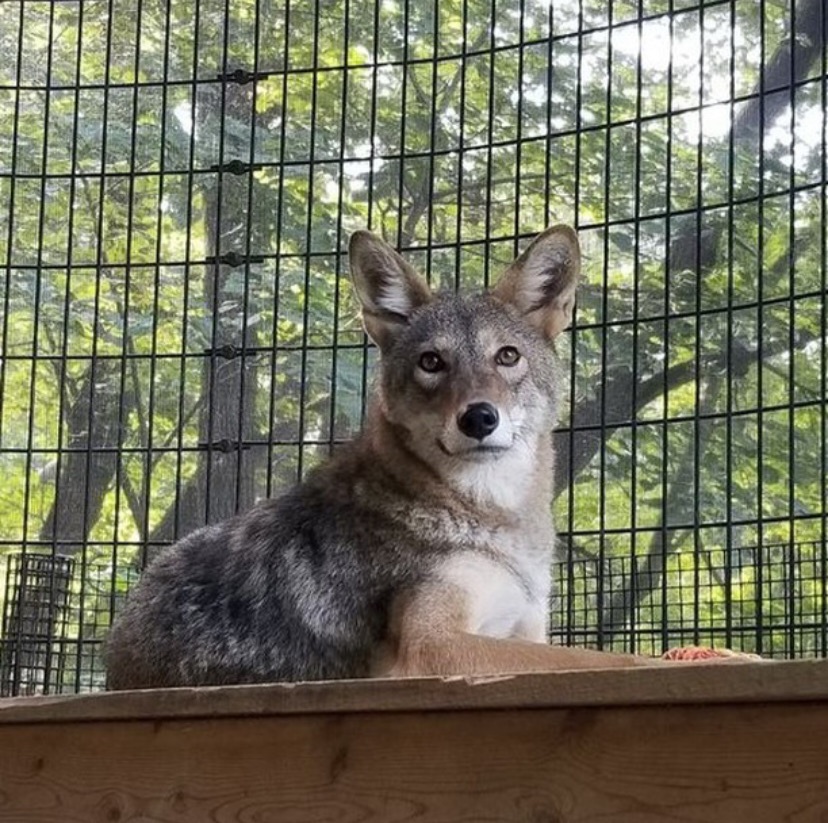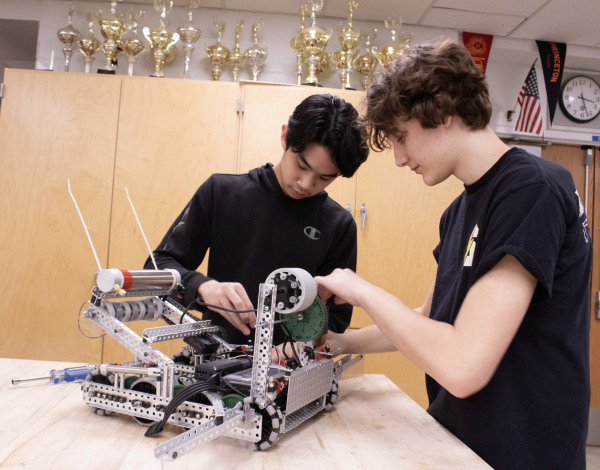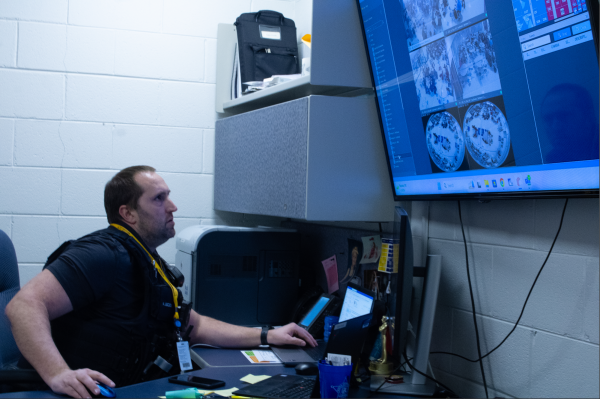Coyote controversy
Battle over Rocky’s home; activists charge inhumane treatment at nature center
February 11, 2022
At only four years old, Rocky the coyote has found himself caught amidst a struggle over his enclosure between River Trail Nature Center, his current home, and activists like Northbrook resident Nicole Milan. Milan alleges the nature center is holding Rocky in inhumane conditions, however, Carl Vogel, Director of Communications for the Forest Preserves of Cook County, noted the nature center has chosen to not give the coyote a name in order to recognize its status as a wild animal—not a pet or mascot—and asserts it is protecting the coyote.
“When my family and I first saw Rocky, we were appalled at his tiny, inhumane cage,” Milan said. “We continually witnessed him stress pacing in his cell with nowhere to escape. This is animal cruelty and we felt it [was] our moral obligation to speak up.”
Although Milan believes the coyote endures inhabitable conditions, the nature center is regularly inspected by the United States Department of Agriculture (USDA) to make sure they are meeting their standards and the coyote is treated well, Vogel explained.
“The Forest Preserves must meet USDA requirements and standards for the enclosure, care, and medical records for the coyote,” Vogel said. “For an enclosure, the animal has [to have] enough room to hide, move around, and make the movements the animal would be able to do in the wild.”
While the coyote’s enclosure is acceptable under the requirements of the USDA—Milan reports it is 28 feet tall and 266 square feet—Nicky Strahl, Illinois Department of Natural Resources Wildlife biologist of Cook County, admitted to the coyote’s cage being small.
“There’s nowhere for him to burrow [into], run, or associate with other animals,” Milan said.
Despite Milan’s claims, Vogel stated experts found the coyote healthy and well taken care of in examinations. Vogel explained a local veterinarian regularly examines the coyote. According to this veterinarian, the coyote is in excellent condition both mentally and physically for a captive animal unable to be released.
Dr. Audrey Siegrist, a veterinarian at Potawatomi Zoo in Indiana who has extensive experience caring for wild animals, has not seen the coyote or its enclosure in-person, but testified before Cook County Commissioners on Jan. 11 saying that based on video footage of the enclosure, the habitat was too small.
“A study by [the] Urban Coyote Research Project of the Chicago area shows that solitary coyotes actually require a larger space than coyotes in a pack,” Siegrist said. “Solitary coyotes have a range up to 10 miles, whereas pack coyotes have a range sometimes two to four miles. It does look like the coyote in question doesn’t have a large enough area.”
In her testimony before Cook County Commissioners on Jan. 11, Dr. Valerie Johnson, a veterinarian with experience working at the Wild Animal Sanctuary in Colorado, expressed her concern over the lack of space between the coyote and people.
“Coyotes and other wild canids are very shy, easily stressed animals,” Johnson said. “They need a place where they can escape from human view if they want to; this is usually provided by dens. This coyote has no place where it can fully escape human view.”
However, Vogel highlighted the nature center offers multiple enrichment activities for the coyote and its enclosure is designed to allow it time away from visitors.
“The coyote’s habitat is designed for it to have places to be away from people, to explore, to climb,” Vogel said. “Our staff provides daily enrichment, including mentally stimulating tasks that require the use of different senses.”
These designs include multiple spaces, both natural and artificial, to give it space from people and to carry out natural behavior, Vogel explained.
“The enclosure has two natural spaces—hollowed logs—as well as two man-made structures where the coyote can climb inside or on top of,” Vogel said. “Two of these four [spaces] don’t face the public, so when the coyote chooses, it can be away from sight. There are also climbing structures: a hammock, two platforms, and several stumps.”
After the coyote’s conditions, Milan began creating a petition to have Rocky relocated to the Wild Animal Sanctuary in Colorado for rehabilitation.
“The Wild Animal Sanctuary [in Colorado] is a renowned sanctuary run by rehabilitation and veterinary experts,” Milan said. “[The sanctuary] rehabilitates animals who’ve been locked in small cages and reintroduces them to a natural environment on hundreds of acres among other carnivores.”
Rocky’s petition has received about 4,000 signatures on change.org, Milan said. She hopes this petition will lead to the coyote’s relocation and allow him to socialize with other carnivores and return to his natural environment.
Additionally, on Sunday, Feb. 13, a silent vigil will be held in protest at River Trail Nature Center. Milan explained the protest will occur at 2:45 p.m., 15 minutes before the coyote is fed.
Based on an official assessment by a Tennessee animal rehabilitator and a veterinarian, Vogel explained because of its time spent in an animal shelter while growing up, the coyote has been imprinted upon and is unable to live in the wild or among other animals.
“The coyote at River Trail is a unique individual,” Vogel said. “It has never lived in the wild or with other coyotes, [and] it does not have the skills or capacity to survive as a lone individual or integrate into a pack. All it has known is living with humans, and the staff at River Trail serves as the coyote’s pack, providing for all of its needs.”
Yet, Johnson explained the Wild Animal Sanctuary utilizes a complex routine to rehabilitate previously captive animals as well as numerous amenities to make their animals feel more comfortable.
“At the Wild Animal Sanctuary the habitats that we provided for coyotes who could not be returned to the wild had a very large area,” Johnson said. “It provides a more natural place for an animal that can’t be released into the wild. The nature center asserts its staff works to properly nurture the coyote; numerous staff members with multiple years of experience and a licensed animal rehabilitator routinely conduct exams, take blood work, and collect fecal matter under the supervision of a wildlife biologist and a local veterinarian.
“Training to the staff is provided by the Forest Preserves’ senior wildlife biologist, who is a co-founder and a published researcher at the Urban Coyote Research Project,” Vogel said. “All the experts involved in the coyote’s care believe the best place for its continued well-being is at River Trail Nature Center. It would cause the coyote great harm to take it away from the only home it has known.”










